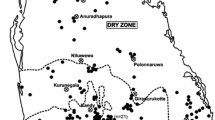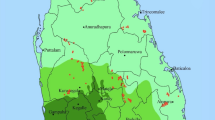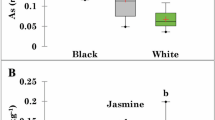Since 2000, collaborative studies for applying NAA have been performed through the Forum for Nuclear Cooperation in Asia (FNCA) sponsored by the Japanese Government. White rice is a main food for Asians and thus was selected as a common target sample for a collaborative study in 2008. Seven Asian countries including China, Indonesia, Japan, Korea, Malaysia, Philippines and Thailand, are greatly concerned about the composition of arsenic, heavy metals, and essential trace elements and took part in this study. Rice samples were purchased and prepared by following a protocol that had been proposed for this study. Samples were analyzed by their own NAA systems. In each country, more than 10 elements were examined and the results were compared. These data will be very useful in the monitoring of the levels of food contamination and to evaluate the nutritional status for people living in Asia.
Similar content being viewed by others
Explore related subjects
Discover the latest articles, news and stories from top researchers in related subjects.Avoid common mistakes on your manuscript.
Introduction
The Forum for Nuclear Cooperation in Asia (FNCA) funded by the Japanese government was established to be recognized as an effective mechanism for enhancing socio-economic development through active regional partnership in the peaceful and safe utilization of nuclear technology in 2000. Collaborative studies applying neutron activation analysis (NAA) have been carried out as one of FNCA projects for applications of nuclear technology for socio-economic development [1, 2].
In the FNCA workshop held in Dalat, Vietnam in 2008, seven Asian countries, China, Indonesia, Japan, Korea, Malaysia, Philippines and Thailand, agreed to participate in a food sample analysis as a sub-theme of the NAA project. Rice was chosen as a common target sample due to it’s importance in terms of a staple food for people living in the Asian region. That is, the major rice production countries in Asia are China, India, Indonesia, Bangladesh, Thailand, etc., and they account for more than 80 percent of the world’s rice production and consumption. It implies that rice provides important information of mineral supplement as well as a large portion of calories for Asians. As scientists have focused their research on health impacts caused by mineral nutrient deficiency and hazardous elements [3–5], public concerns about mineral intake by dietary food is rising worldwide.
The objectives of this study were to determine inorganic elemental contents in white rice of seven Asian countries by NAA and to assist the evaluation of rice in nutritional and toxic levels for the populations of these seven participating countries.
Experimental
Sampling and sample preparation
Rice sample collection and its preparation for INAA in each country are given in Table 1. The collected rice grains were cleaned once with tap water, twice with deionized (DI) water and then dried in a hot-air oven at 60 °C for 4 h. And then, the sample was ground into fine particles using a high-speed blender made of titanium to reduce contamination. The grinding step was repeated until fine particles passed completely through a No. 60 mesh sieve. Finally, three replicates with sample weights of 100–300 mg were prepared for instrumental neutron activation analysis (INAA).
Instrumental neutron activation analysis
The samples prepared for INAA by each country, and certified reference materials for analytical quality control, were analyzed using their own NAA facilities excluding the Philippines, which used the same facility as Japan. Detailed information is summarized in Table 2. The samples were activated by short and long irradiation to detect short-, median- and long-lived nuclides. In order to detect the gamma-rays emitted from the irradiated samples, HPGe detectors coupled to multichannel analyzers were used. Consequently, the elemental content was determined by relative method and/or k 0-method.
Results and discussion
Inorganic elemental contents in white rice samples
Fifteen elements were determined by seven participating countries, and the results are summarized in Table 3. With respect to analytical quality control, various reference materials as described in Table 2 were analyzed, and the results for fifteen elements are summarized in terms of relative error (%) with absolute values, which are shown in Fig. 1. The relative errors of most of the elements evaluated in Fig. 1 are within 15% except a few elements.
In Table 3, K results presented the highest values among the analyzed elements within a range of 573 to 977 mg/kg and following K are Cl and Mg. Seven elements such as As, Br, Cl, K, Mn, Na, and Zn were determined by all participating countries. China has the highest value of As, 0.55 mg/kg and the other countries show a similar As contents, approximately 0.1 mg/kg. For Br, Malaysia and Philippines have ten times the level of the other countries. For the other five elements, there is no significant difference and the mean concentration and their standard deviation for Cl, K, Mn, Na, and Zn were 229 ± 23, 688 ± 137, 8.46 ± 1.29, 7.31 ± 3.52 and 17.2 ± 4.6 mg/kg, respectively. Al and Mg concentrations were determined from six countries excluding Malaysia. Indonesia shows a remarkably high Al value, 20.52 mg/kg and Thailand has the lowest Mg content, 59 mg/kg. Ca data were provided from Japan, Korea and the Philippines which are 49.5, 53.9 and 39.1 mg/kg. Other countries show lower than 15 mg/kg of Ca. The concentrations for Cr, Cs, Fe, and Rb in Indonesian rice are much higher than those of other countries. Chinese rice presented the highest Mg content of 379 mg/kg.
Evaluation of dietary intake level for harmful and essential elements
In order to estimate the dietary intake of inorganic constituents via white rice, a daily consumption survey is indispensible. For instance, the daily average consumption of rice in Korea in 2000 was 256 g (Ministry of Agricultural and Forestry of Korea, 2003) [6]. However, rice consumption must be dependent on each country’s situation. Hence, assuming that the average consumption of rice is 300 g/day for a comparison of daily intake levels among the seven countries, daily intake values can be simply calculated for five elements such as As, K, Mn, Na and Zn determined from all participating countries and known to be harmful or essential in human body, as shown in Table 4. In the mean time, the Joint Food and Agriculture Organization of the United Nations and the World Health Organization Expert Committee on Food Additives (JECFA) have set a recommended weekly safe exposure limit, which is 15 μg/kg of body weight for inorganic As [7]. Assuming that the body weight of an adult is 70 kg, the daily safe exposure limit of As is equal to 150 μg. In addition, the Institute of Medicine (IOM) in the United States has set the values of recommended dietary allowance (RDA) or adequate intake (AI) for essential elements [8–11]. RDA for Mn and Zn were set as 330 mg/day for adult men (19–30 years) and 14 mg/day for men, respectively. AI for K and Na set by IOM are 4.7 g/day for all adults and 1.5 g/day for young adults, respectively. Daily dietary levels (%) for five elements according to a safe limit, RDA and AI, was obtained and shown in Fig. 2. Dietary level (DL) of As in China surpasses the recommended safe exposure limits of JECFA and the others are within the safe limits. Although the Mn level is almost equal to the value of RDA, it is lower than the tolerable upper intake level value, 11 mg/day recommended by IOM. In case of Zn, the range of DL is 21.6–51.9%. The range of DL K is 3.7–6.2% of AI, and Na is lower than 0.3% of AI.
Conclusion
A collaborative study for the analysis of white rice among seven Asian countries was carried out for applications of nuclear technology for socio-economic development. Fifteen elements from white rice samples were determined by INAA. The analytical data were compared between participating countries and daily dietary intake levels were evaluated in comparison with recommended dietary allowance and adequate intake values set by IOM. The current data showed no significant contamination of heavy metals in rice samples from participating countries. It is expected that FNCA will keep playing an important role in consolidating collaboration studies among Asian countries.
References
Ebihara M, Chung YS, Chueinta W, Ni BF, Otoshi T, Oura Y, Santos FL, Sasajima F, Sutisna, Wood AKBH (2006) J Radioanal Nucl Chem 269(2):259–266
Ebihara M, Chung YS, Dung HM, Moon JH, Ni BF, Otoshi T, Oura Y, Santos FL, Sasajima F, Sutisna, Wee BS, Wimolwattanapun W, Wood AKBH (2008) J Radioanal Nucl Chem 278(2):463–467
World Health Organization (2006) Trace elements in human nutrition and health. WHO, Geneva
Lee RM (2003) Minerals in animal and human nutrition. Elsevier Science BV, Amsterdam
Garrow JS, James WPT, Ralph A (2000) Human nutrition and dietetics. Elsevier, Amsterdam
Ministry of Agriculture and Forestry (2003) Agricultural and forestry statistical yearbook 2003. Ministry of Agriculture and Forestry, Seoul
Joint FAO/WHO Expert Committee on Food Additives (1989) Evaluation of certain food additives and contaminants, Thirty-third report of the joint FAO/WHO expert committee on food additives, WHO technical report series, vol 776. WHO, Geneva
Institute of Medicine, Food and Nutrition Board (1997) Dietary reference intakes for calcium, phosphorous, magnesium, vitamin D and fluoride. National Academy of Sciences, Washington DC
Institue of Medicine, Food and Nutrition Board (2001) Dietary reference intakes for vitamin A, vitamin K, arsenic, boron, chromium, copper, iodine, iron, manganese, molybdenum, nickel, silicon, vanadium, and zinc. National Academy of Sciences, Washington DC
Institue of Medicine, Food and Nutrition Board (2004) Dietary reference intakes for water, potassium, sodium, chloride and sulfate. National Academy of Sciences, Washington DC
Institue of Medicine (2010) Dietary reference intakes for calcium and vitamin D. Report Brief, November, 2010
Acknowledgment
This research has been carried out by the support of the Ministry of Education, Culture, Science and Technology of Japan.
Author information
Authors and Affiliations
Corresponding author
Rights and permissions
About this article
Cite this article
Moon, J.H., Ebihara, M., Ni, B.F. et al. A NAA collaborative study in white rice performed in seven Asian countries. J Radioanal Nucl Chem 291, 217–221 (2012). https://doi.org/10.1007/s10967-011-1245-1
Received:
Published:
Issue Date:
DOI: https://doi.org/10.1007/s10967-011-1245-1






